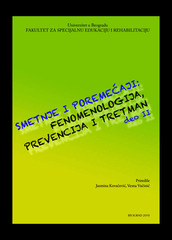Приказ основних података о документу
Bihejvioralni i emocionalni problemi osoba sa intelektualnom ometenošću
Behavioral and emotional problems of persons with intellectual disability
| dc.contributor | Kovačević Jasmina | |
| dc.contributor | Vučinić Vesna | |
| dc.creator | Brojčin, Branislav | |
| dc.creator | Glumbić, Nenad | |
| dc.creator | Milačić-Vidojević, Ivona | |
| dc.date.accessioned | 2021-06-17T12:40:51Z | |
| dc.date.available | 2021-06-17T12:40:51Z | |
| dc.date.issued | 2010 | |
| dc.identifier.isbn | 978-86-80113-99-9 | |
| dc.identifier.isbn | 978-86-80113-99-9 | |
| dc.identifier.uri | http://rfasper.fasper.bg.ac.rs/handle/123456789/1799 | |
| dc.description.abstract | Problemi u ponašanju uobičajeni su među osobama sa intelektualnom ometenošću (IO). Teško ih je definisati jer zavise od percepcije ljudi iz okoline ovih osoba. Osobe sa IO koje ispoljavaju problematično ponašanje, pod povećanim su rizikom od smeštanja u psihijatrijske ustanove. Navodi se da je učestalost psihopatoloških poremećaja od tri do četiri puta veća nego u opštoj populaciji, dok se procene učestalosti poremećaja ponašanja kod dece i adolescenata sa IO kreću od 30% do 60%. U radu se razmatra povezanost bihejvioranih i emocionalnih problema sa nivoom intelektualnog funkcionisanja, uzrastom, obrazovnim okruženjem i epileptičkim statusom osoba sa IO. Takođe se razmatra ispoljavanje nekih od ovih problema kod osoba sa IO, poput agresivnosti, samopovređivanja i stereotipnih ponašanja, poremećaja raspoloženja i poremećaja mišljenja. | |
| dc.description.abstract | Behavioral problems are quite common among persons with intellectual disability (ID). However, these problems are not easily defined because they depend on perception of the surrounding. Persons with ID who manifest behavioral problems are more likely to be institutionalized in psychiatric institutions. It is estimated that persons with ID are three to four times more likely than typical population to have psychopathological disorders. In addition, it is believed that 30% to 60% of children and adolescents with ID also have behavioral disorders. This article deals with relationship between behavioral-emotional problems and the level of intellectual functioning, age, educational setting and epilepsy of the persons with ID. Certain manifestation of these problems such as aggression, self-mutilation, stereotyped behavior, mood disorders and thinking disorders are also discussed. | |
| dc.language | sr | |
| dc.publisher | Univerzitet u Beogradu – Fakultet za specijalnu edukaciju i rehabilitaciju/ University of Belgrade – Faculty of Special Education and Rehabilitation | |
| dc.rights | openAccess | |
| dc.rights.uri | https://creativecommons.org/licenses/by-sa/4.0/ | |
| dc.source | Zbornik radova - „ Smetnje i poremećaji: fenomenologija, prevencija i tretman deo II / Disabilities and Disorders: Phenomenology, Prevention and Treatment Part I I “,Beograd / Belgrade 2010 | |
| dc.subject | bihejvioralni i emocionalni problemi | |
| dc.subject | intelektualna ometenost | |
| dc.subject | faktori | |
| dc.subject | behavioral and emotional problems | |
| dc.subject | intellectual disability | |
| dc.subject | factors | |
| dc.title | Bihejvioralni i emocionalni problemi osoba sa intelektualnom ometenošću | sr |
| dc.title | Behavioral and emotional problems of persons with intellectual disability | |
| dc.type | conferenceObject | |
| dc.rights.license | BY-SA | |
| dc.citation.epage | 364 | |
| dc.citation.other | http://www.vbs.rs/scripts/cobiss?ukaz=DISP&id=0808003435197984&rec=1&sid=1 | |
| dc.citation.rank | M14 | |
| dc.citation.spage | 349 | |
| dc.identifier.fulltext | http://rfasper.fasper.bg.ac.rs/bitstream/id/7649/Untitled24.pdf | |
| dc.identifier.rcub | https://hdl.handle.net/21.15107/rcub_rfasper_1799 | |
| dc.type.version | publishedVersion |


